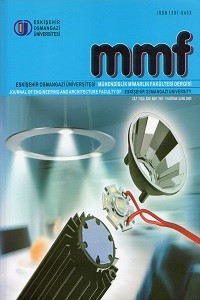Öz
Turkey is in high seismic risk zone. On a possible earthquake, adjacent buildings which are not separated from each other properly are under pounding risk. Although gap size requirements are given in Turkish Earthquake Code (TEC), in Turkey, adjacent buildings are still been constructing with insufficient gap sizes. In this paper; results of pounding and effects of pounding to structural elements of buildings are studied. Stress analyses are made on frame models for different impact points and analysis results are discussed. It is concluded that pounding forces are not completely absorbable because of their high values but their effects on structure can be reduced by placing elastic materials between adjacent buildings or by reinforcing structural systems with cast-in-place reinforced concrete (RC) walls.
Anahtar Kelimeler
Kaynakça
- [1] S. Muthukumar and R. DesRoches, “A Hertz contact model with non-linear damping for simulation”, Earthquake Eng. and Structural Dynamics, Vol. 35, pp. 811-828, 2006.
- [2] S.E. AbdelRaheem, “Seismic pounding between adjacent building structures”, Electronic Journal of Structural Engineering, Vo. 6, pp. 66-74, 2006.
- [3] B.D.Westermo, “The Dynamics of interstructural connection to prevent pounding”, Earthquake Engineering and Structural Dynamics, Vol. 18, pp. 687-699, 1989.
- [4] B.F. Maison and K.Kasai, “Analysis for type of structural pounding”, Journal of Structural Engineering, Vol. 116(4), pp. 957-975, 1990.
- [5] S.A. Anagnostopoulos, “Pounding of buildings in series during earthquakes”, Earthquake Engineering and Structural Dynamics, Vol.16, pp. 443-456, 1988.
- [6] S.A. Anagnostopoulos, “An Investigation of earthquake induced pounding between adjacent buildings”, Earthquake Eng.and Structural Dynamics, Vol. 21, pp. 289-302, 1992.
- [7] D.L. Garcia, “Discussion on: Critical building separation in reducing pounding risk under earthquake excitation”, Structural Safety, Vol. 27, pp. 393-396, 2005.
- [8] V.A. Matsagar and R.S. Jangid, “Viscoelastic damper connected to adjacent structures involving seismic isolation”, Journal of Civil Engineering and Management, Vol. 11(4), pp. 309-322,2005.
- [9] The Ministry of Public Works and Settlement, Turkish Earthquake Code, 2007.
- [10] C.E.N. Eurocode 8: Design of Structures for Earthquake Resistance, European Committee for Standardization, 1998.
- [11] C.S.I. SAP2000 Advanced v10.0.7 (Structural Analysis Program), Computers and Structures Inc., 2007.
Öz
Turkey is in high seismic risk zone. On a possible earthquake, adjacent buildings which are not separated from each other properly are under pounding risk. Although gap size requirements are given in Turkish Earthquake Code (TEC), in Turkey, adjacent buildings are still been constructing with insufficient gap sizes. In this paper; results of pounding and effects of pounding to structural elements of buildings are studied. Stress analyses are made on frame models for different impact points and analysis results are discussed. It is concluded that pounding forces are not completely absorbable because of their high values but their effects on structure can be reduced by placing elastic materials between adjacent buildings or by reinforcing structural systems with cast-in-place reinforced concrete (RC) walls.
Anahtar Kelimeler
Kaynakça
- [1] S. Muthukumar and R. DesRoches, “A Hertz contact model with non-linear damping for simulation”, Earthquake Eng. and Structural Dynamics, Vol. 35, pp. 811-828, 2006.
- [2] S.E. AbdelRaheem, “Seismic pounding between adjacent building structures”, Electronic Journal of Structural Engineering, Vo. 6, pp. 66-74, 2006.
- [3] B.D.Westermo, “The Dynamics of interstructural connection to prevent pounding”, Earthquake Engineering and Structural Dynamics, Vol. 18, pp. 687-699, 1989.
- [4] B.F. Maison and K.Kasai, “Analysis for type of structural pounding”, Journal of Structural Engineering, Vol. 116(4), pp. 957-975, 1990.
- [5] S.A. Anagnostopoulos, “Pounding of buildings in series during earthquakes”, Earthquake Engineering and Structural Dynamics, Vol.16, pp. 443-456, 1988.
- [6] S.A. Anagnostopoulos, “An Investigation of earthquake induced pounding between adjacent buildings”, Earthquake Eng.and Structural Dynamics, Vol. 21, pp. 289-302, 1992.
- [7] D.L. Garcia, “Discussion on: Critical building separation in reducing pounding risk under earthquake excitation”, Structural Safety, Vol. 27, pp. 393-396, 2005.
- [8] V.A. Matsagar and R.S. Jangid, “Viscoelastic damper connected to adjacent structures involving seismic isolation”, Journal of Civil Engineering and Management, Vol. 11(4), pp. 309-322,2005.
- [9] The Ministry of Public Works and Settlement, Turkish Earthquake Code, 2007.
- [10] C.E.N. Eurocode 8: Design of Structures for Earthquake Resistance, European Committee for Standardization, 1998.
- [11] C.S.I. SAP2000 Advanced v10.0.7 (Structural Analysis Program), Computers and Structures Inc., 2007.
Ayrıntılar
| Konular | İnşaat Mühendisliği |
|---|---|
| Bölüm | Araştırma Makaleleri |
| Yazarlar | |
| Yayımlanma Tarihi | 30 Haziran 2009 |
| Kabul Tarihi | 22 Ocak 2009 |
| Yayımlandığı Sayı | Yıl 2009 Cilt: 22 Sayı: 1 |


